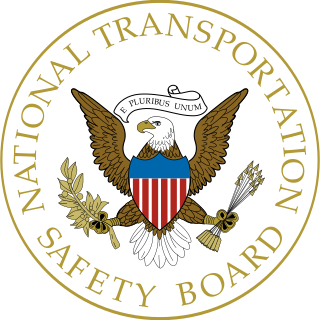
The National Transportation Safety Board (NTSB) is an independent U.S. government investigative agency responsible for civil transportation accident investigation. In this role, the NTSB investigates and reports on aviation accidents and incidents, certain types of highway crashes, ship and marine accidents, pipeline incidents, bridge failures, and railroad accidents. The NTSB is also in charge of investigating cases of hazardous materials releases that occur during transportation. The agency is based in Washington, D.C. It has four regional offices, located in Anchorage, Alaska; Denver, Colorado; Ashburn, Virginia; and Seattle, Washington. The agency also operates a national training center at its Ashburn facility.

An aviation accident is an event during aircraft operation that causes serious injury, death, or destruction; an aviation incident is any operating event that compromises safety but does not progress to an actual accident. Preventing accidents and incidents is the main goal of aviation safety.

The Air Accidents Investigation Branch (AAIB) investigates civil aircraft accidents and serious incidents within the United Kingdom, its overseas territories and crown dependencies. It is also the Space Accident Investigation Authority (SAIA) for the United Kingdom. The AAIB is a branch of the Department for Transport and is based in the grounds of Farnborough Airport, Hampshire.

Aviation safety is the study and practice of managing risks in aviation. This includes preventing aviation accidents and incidents through research, educating air travel personnel, passengers and the general public, as well as the design of aircraft and aviation infrastructure. The aviation industry is subject to significant regulation and oversight.

A flight recorder is an electronic recording device placed in an aircraft for the purpose of facilitating the investigation of aviation accidents and incidents. The device may often be referred to colloquially as a "black box", an outdated name which has become a misnomer—they are now required to be painted bright orange, to aid in their recovery after accidents.

Adam Air was a privately owned airline based in West Jakarta, Jakarta, Indonesia. It operated scheduled domestic services to over 20 cities and international services to Penang and Singapore. Its main base was Soekarno-Hatta International Airport, Jakarta.

Pakistan International Airlines Flight 268 was an Airbus A300, registration AP-BCP, which crashed while approaching Kathmandu's Tribhuvan International Airport on 28 September 1992. All 167 people on board were killed. Flight 268 is the worst crash of Pakistan International Airlines, and the worst ever to occur in Nepal.

Pakistan Civil Aviation Authority (PCAA) is a state-owned autonomous body under the administrative control of the Secretary to the Government of Pakistan for Aviation, which oversees and regulates all aspects of civil aviation in Pakistan. PCAA's head office is situated in Terminal-1 of Jinnah International Airport in Karachi. PCAA is a member state of the International Civil Aviation Organization. Nearly all 44 civilian airports in Pakistan are owned and operated by the PCAA.
An Air Data Inertial Reference Unit (ADIRU) is a key component of the integrated Air Data Inertial Reference System (ADIRS), which supplies air data and inertial reference information to the pilots' electronic flight instrument system displays as well as other systems on the aircraft such as the engines, autopilot, aircraft flight control system and landing gear systems. An ADIRU acts as a single, fault tolerant source of navigational data for both pilots of an aircraft. It may be complemented by a secondary attitude air data reference unit (SAARU), as in the Boeing 777 design.

Crossair Flight 498 was a scheduled commuter flight from Zürich, Switzerland, to Dresden, Germany. On 10 January 2000, the Saab 340B operating the flight crashed two minutes after takeoff in the Swiss municipality of Niederhasli on 10 January 2000, killing all 10 passengers and crew. It was one of two fatal crashes for Crossair in its 25-year history; the other was Crossair Flight 3597 which crashed less than 2 years later during approach to Zurich.

British Airways Flight 38 was a scheduled international passenger flight from Beijing Capital International Airport in Beijing, China, to London Heathrow Airport in London, United Kingdom, an 8,100-kilometre trip. On 17 January 2008, the Boeing 777-200ER aircraft operating the flight crashed just short of the runway while landing at Heathrow. No fatalities occurred; of the 152 people on board, 47 sustained injuries, one serious. It was the first time in the aircraft type's history that a Boeing 777 was declared a hull loss, and subsequently written off.

Yeti Airlines Flight 101 was a domestic flight in Nepal, that crashed on final approach to Tenzing-Hillary Airport in the town of Lukla in eastern Nepal on 8 October 2008. The De Havilland Canada DHC-6 Twin Otter Series 300 registered as 9N-AFE originated from Tribhuvan International Airport in Kathmandu.

Qantas Flight 72 (QF72) was a scheduled flight from Singapore Changi Airport to Perth Airport by an Airbus A330. On 7 October 2008, the flight made an emergency landing at Learmonth Airport near the town of Exmouth, Western Australia, following an inflight accident that included a pair of sudden, uncommanded pitch-down manoeuvres that caused severe injuries—including fractures, lacerations and spinal injuries—to several of the passengers and crew. At Learmonth, the plane was met by the Royal Flying Doctor Service of Australia and CareFlight. Fourteen people were airlifted to Perth for hospitalisation, with thirty-nine others also attending hospital. In all, one crew member and eleven passengers suffered serious injuries, while eight crew and ninety-nine passengers suffered minor injuries. The Australian Transport Safety Bureau (ATSB) investigation found a fault with one of the aircraft's three air data inertial reference units (ADIRUs) and a previously unknown software design limitation of the Airbus A330's fly-by-wire flight control primary computer (FCPC).

Lao Airlines Flight 301 was a scheduled domestic passenger flight from Vientiane to Pakse, Laos. On 16 October 2013, the ATR 72-600 aircraft operating the flight crashed into the Mekong River near Pakse, killing all 49 people on board. The accident was the first involving an ATR 72-600 and the deadliest ever to occur on Laotian soil.

Tatarstan Airlines Flight 363 was a scheduled domestic passenger flight, operated by Tatarstan Airlines on behalf of Ak Bars Aero, from Moscow to Kazan, Russia. On 17 November 2013, at 19:24 local time (UTC+4), the Boeing 737-500 crashed during an aborted landing at Kazan International Airport, killing all 44 passengers and 6 crew members on board, making it 2013's worst plane crash.

Loganair Flight 670A (LC670A) was a scheduled cargo flight for the Royal Mail from Edinburgh-Turnhouse Airport, Scotland to Belfast International Airport. On 27 February 2001 the Short 360 operating the flight ditched in the Firth of Forth off Edinburgh at around 17:30 local time; the two crewmembers' bodies were found in the wreckage a few hours after the crash.
The Air Accident Investigation Bureau is an independent body that investigates civil aviation accidents and incidents that occur in Malaysia, in line with the guidance provided in the Annex 13 of the Convention on International Civil Aviation and in compliance with the requirements of the Civil Aviation Regulations 2016. The AAIB operates under of the Ministry of Transport of the Government of Malaysia, stationed in Putrajaya, and reports directly to the Minister of Transport.

Yeti Airlines Flight 691 was a scheduled domestic passenger flight flown by Yeti Airlines from Kathmandu to Pokhara in Nepal. On 15 January 2023, an ATR 72, the aircraft being operated on the route, stalled and crashed while landing at Pokhara. All 72 people on board died on impact.

On 21 May 2024, a Singapore Airlines Boeing 777-312ER operating as Flight 321, flying a scheduled passenger flight from London Heathrow Airport to Singapore Changi Airport carrying 229 occupants on board, encountered severe turbulence over Myanmar, resulting in 1 death and 104 injuries. The aircraft subsequently made an emergency landing at Suvarnabhumi Airport in Bangkok. The accident was Singapore Airlines' first fatal aviation accident since the crash of Flight 006 in 2000.

















